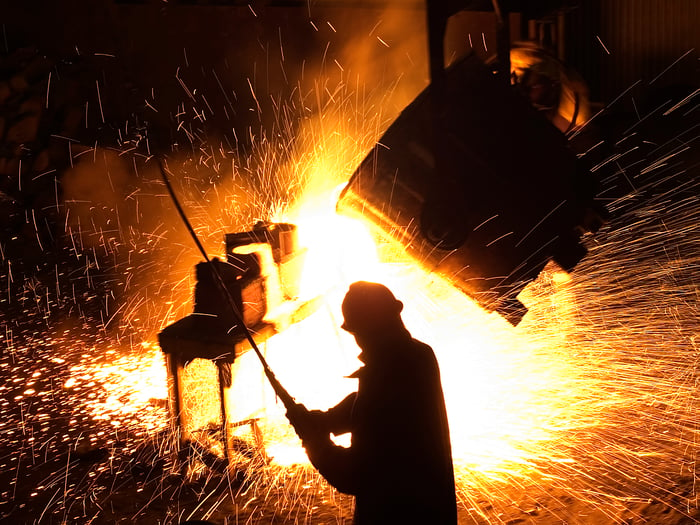United States Steel (X) tracks its history back to 1901, making it one of the oldest steel companies in the world. It has literally helped to build the American economy for more than 100 years, since steel is so important to industrial development. That said, this "old dog" is trying to learn some new tricks for some very important reasons.
Here's what you need to know.
Old company, new technology
There are two dominant steelmaking processes. The first, and older method, is to produce primary steel in blast furnaces. This approach, to simplify things dramatically, takes raw iron and melts it to produce steel.
Blast furnaces are extremely expensive facilities that need to be run at high capacities to turn a profit. When demand softens, they tend to bleed red ink while periods of high demand can lead to very robust profits. This is one of the reasons the steel industry is so cyclical, going from good times to bad, since steel demand is tied to economic activity.

Image source: Getty Images.
U.S. Steel's long history has left it with a heavy focus on blast furnaces. A newer technology that underpins steel industry giant Nucor's (NUE -0.48%) business is the electric arc mini-mill. To keep things simple, mini-mills are smaller and use electricity to melt scrap steel. These mills are easier to ramp up and down along with demand and tend to produce more consistent and resilient profits. To highlight how resilient electric arc mini-mills are, Nucor has increased its dividend every year for 50 consecutive years.
For a cyclical company to achieve Dividend King status requires more than just good technology, but that technology is an important differentiating factor that has to be considered. Notably, U.S. Steel's dividend hasn't been anywhere near as consistent.
NUE Dividend Per Share (Annual) data by YCharts
U.S. Steel is changing with the times
The interesting thing is that the world needs the primary steel that is produced in blast furnaces. Without that production, there would be less and less scrap steel to use in electric arc mini-mills. So U.S. Steel can't really just switch its production method. However, it has made the choice to broaden its options with a strategy it has dubbed "best for all." The basic idea is to add electric arc mini-mills into its production portfolio.
It takes a long time to build steel mills, even the smaller mini-mills, so this is a multi-year crusade. In fact, U.S. Steel started by acquiring a company that was building a mini-mill and has since enhanced its capital investment in mini-mills. But it helps to understand just how different these mills are from blast furnaces.
During U.S. Steel's first-quarter 2023 earnings conference call, management laid out some key figures. For example, it costs around $15 per ton of steel in sustaining capital investment per year to keep a mini-mill going versus around $30 for U.S. Steel's legacy assets. That's a massive 50% savings. The company expects its mini-mill segment to have 20% plus margins and produce around $1.3 billion in earnings before interest, taxes, depreciation, and amortization (EBITDA) through the cycle, helping to smooth out the performance of its more variable blast furnace operations.
On top of the financial benefit, there's an environmental benefit as well. The company estimates that its electric arc mini-mills will produce between 70% and 80% fewer greenhouse gas emissions than blast furnace technology. So not only is U.S. Steel creating a stronger business financially, but also one that is better positioned to weather the transition toward fewer emissions.
Looking more like Nucor
At this point, U.S. Steel doesn't seem destined to switch wholesale to mini-mills and, frankly, that would probably be a mistake given the need for primary steel produced in blast furnaces. However, it is clearly working to become more like U.S. industry giant Nucor, which has proven to be a far more resilient business over time. That's likely to be a good choice for the company and investors. Sure, U.S. Steel's business will still be more cyclical than Nucor's, but it will be less cyclical than it was not too long ago.






